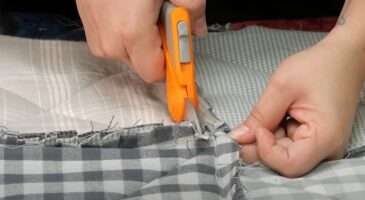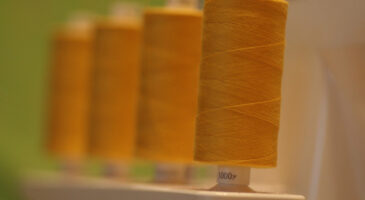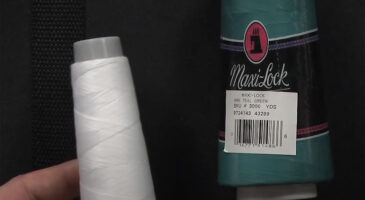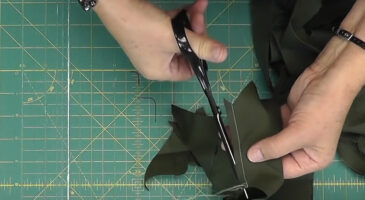Velcro is a well-known item and is widely used for different purposes all around the world. Some people use it for toys or clothes, while others attach any two things that need to be together. Velcro is a simple hook-and-loop fastener.
The items consist of two skinny strips where one has minor hooks all across the stripe while the other has many loops that look like a mesh. Because of its adhesive properties and small size, this item has many applications and can be used in various minor to significant tasks of daily life.
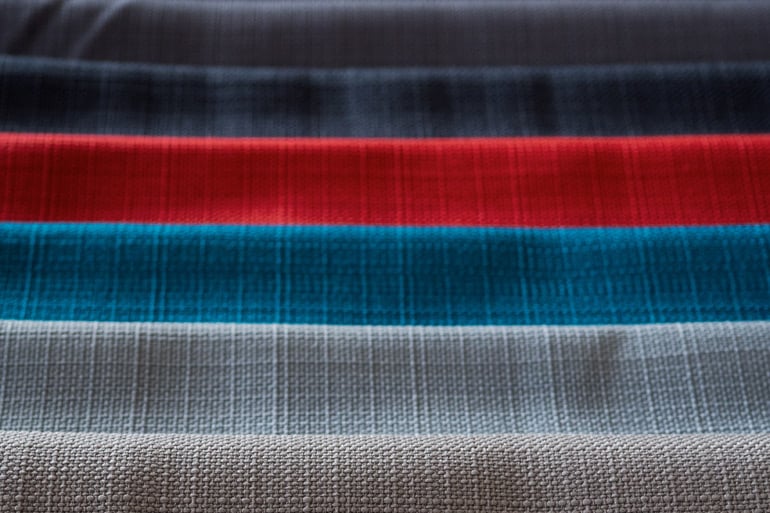
Whether we talk about large-scale companies or small household projects, velcro is handy, but the thing is that velcro doesn’t usually stick to all fabrics efficiently.
If you are here, you have questions like, What fabric does velcro stick to? How to make velcro stick to fabric? Just continue reading, and you will have all your answers as soon as you reach the final word of this article.
What fabric does velcro stick to?
It mainly depends on the side of the velcro you are attaching to your clothes. The adhesive or mesh-like side of velcro having mini loops will stick to light fabrics, while the velcro side with hooks can easily stick to any fabric with a loops-like texture.
The sticky back or loops side of the velcro can stick to fabrics like:
The hook side of the velcro can stick to fabrics with mini loops like:
What fabric does iron-on velcro stick to?
The iron-on velcro can stick to many thicker fabrics than light fabrics but thinner than wool. Some primary fabrics or substitutes efficiently compatible with iron-on velcro include nylon, denim, canvas, suede, fleece, felt, polyester, and, most importantly, cotton blends.
Can you sew velcro on fabric?
Sewing machines are designed to stitch through all heavy and light fabrics, so you can put velcro on any of your fabrics and start sewing. The only thing to ensure is to use a heavy-duty needle that is strong enough to handle the stiff nature of the velcro without breaking down in the middle.
All velcro is not the same, and they differ in terms of stiffness and compatibility with sewing machines. Look for a velcro that is non-adhesive because velcro with adhesives is challenging to sew and can also damage the cloth.
Also, it should be soft as it will allow you to quickly and efficiently bend the velcro along with your fabric.
What is the best stitch for velcro?
Blind hem and zigzag stitches are recommended for velcro as they keep it in place while offering enough flexibility. The needle should be positioned down, which makes it easy for the needle to pivot.
Also, reduce the stitch length to a certain extent to prevent any skipped stitches on the velcro. Before you move on to sewing velcro, it is essential to clip off the sharp edges, as they will become difficult to remove after stitching.
What side of velcro should I attach to the cloth?
There are two sides, one with hooks and the other with minimum loops. The velcro’s hook side is pointy, meaning it should be stitched on the fabric while opposing your body.
The mini loops should face your body as they will be pulled or pushed to attach with hooks. This pattern protects your skin from scratches in one place while making it easy for you to open velcro, as detaching the loop side from hooks is easy compared to the other way around.
How do you attach velcro to fabric without sewing?
As there are different types of velcro, the methods differ for each one. For simple velcro strips, all you do is put it on the fabric and sew stitches on the edges just like you sew any other accessories on your clothes for design.
But people wonder, is there any way to attach velcro to fabric without sewing? Below are the two best additionals that can help you attach velcro to fabric without sewing.
Using velcro adhesives:
Some people prefer attaching velcro strips to fabrics without stitches, and the very first adhesive they think of is a heavy-duty glue. A high-quality glue is excellent for this purpose, but it is also recommended to look for adhesives that are specifically formulated and manufactured to attach the velcro.
It is always a good practice to look at the adhesive wrapper because each adhesive is different in terms of temperature, sunlight, and water resistance. You should choose the one that suits you the best in your region’s weather.
Using fabric-based tape:
Fabric-based tape is too famous among sewists because of its ease of installation and strong bond. You have nothing to do except buy fabric-based tape, peel it off, and attach the velcro to the fabric.
Make sure you put it in the right place because it forms a strong bond without requiring anything like stitches, glues, adhesives, or even iron. It is recommended to put some weight on after attaching the velcro and let it stay still for about 24 hours, as it can take much time to get permanently set.
Here is a video by “ehowbeauty” that will show a brief visual representation of different methods that can be used to attach velcro to your fabrics.
Why does thread keep breaking while sewing velcro?
The thread usually breaks very often when you are sewing velcro with adhesives. Make sure that you are sewing regular velcro with fabric because if there is any sticky tape or glue under the velcro (where stitches are seaweed), there are a lot of chances that either your needle or thread will break during the process.
The thing is that adhesives can cause the needle and thread to glue up, resulting in broken threads as the force is applied to pull the needle up from the fabric.
What is the best velcro for your fabric?
Any velcro that is soft, flexible, and has no glue, sticky tape, or adhesives will be good to sew on fabrics. However, below are some of the best velcro by some well-known brands that sewists use worldwide.
- Darice Hook and Loop Strips
- Homepie Store Sew-On Hook-and-Loop Strips
- Yongshi Sew-On Hook-and-Loop Fasteners
- Scotch Extreme Fasteners
- Velcro Sew On Snag-Free Tape
How do I fix the velcro that doesn’t stick?
Velcro can get clogged over time because of tiny threads coming from the clothes. The best way to fix such velcro is to rub the toothbrush thoroughly and forcefully. It is better to start with the hook side, and if the problem is solved, there is no need to brush the mini lops side.
However, if there is debris and threads on the loop side, you should also brush that part while making sure that you don’t pull out most of the mini loops, making it way less sticky.
You don’t need to unstitch the velcro, lay the fabric flat on the table and do the removal process as prescribed.
How to remove velcro from fabric?
Removing non-adhesive velcro is easy as you can break the stitches and remove them from the place. However, if you have put velcro tape on your fabric, you need a proper procedure to remove it without affecting the fabric.
- Take any citrus products, such as lemon juice.
- Pour the juice directly on the tape thoroughly, especially on the edges, as it will make removal easy.
- Let the lemon juice or other citrus products you use work for about 5-15 minutes.
- Now rub the edges of the tape while lemon juice is still on velcro.
- Start scraping velcro tape from the fabric. Initiate from one edge and then move towards the middle of the tape.
- You may apply lemon juice if velcro tape is not coming out but once it starts coming out quickly, stop pouring any more citrus on the tape.
FAQs:
Can you iron velcro?
Yes, you can iron velcro of all types without any concerns. Instead, there is also a type of velcro that doesn’t need to be sewn or stitched; you can put it on the clothes that need to be attached.
Then iron the tape right on its back side, and a firm, everlasting bond will form between the fabrics and the velcro.
Can you trim velcro?
Yes, this is why it is relatively inexpensive to buy. You can buy a single long strip of velcro and cut it to the size you need. You can trim its edges to make it less comprehensive or protect your skin from scratches from sharp edges or corners of velcro.
How long does velcro last?
Each time you pull the mini loop’s side of the velcro, it is counted as a separation cycle. Experts and manufacturers claim that velcro can last as many as 20,000 cycles.
This is a huge number of cycles, so if you separate the hook and loop twice a day, it will take about 27 years before velcro becomes non-sticky.
Clogging of threads, dust, debris, and exposure to extreme sunlight for a long time can affect their life, but still, it lasts longer than the cloth itself.
